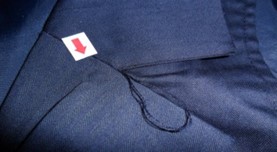Defect Calibration: A Key Tool for Reducing Errors and Chargebacks
May 8, 2017

By Jose Suarez
In the fast-paced, competitive apparel and footwear industries, quality has always been important. However, with rising material and labor costs, combined with the growing pressure for faster deliveries and the proliferation of styles, minimizing defects is no longer just important; it’s essential.
Therefore, as part of their efforts to ensure short- and long-term growth, forward-thinking brands are investing in defect calibration, the practice of minimizing quality discrepancies that exist when a product is manufactured.
The Importance of Outlining Quality Standards and Expectations
To achieve effective defect calibration, brands must methodically outline quality standards and expectations regarding defect classification with their factories.
While this action may seem obvious, consider the state of communication and understanding at your factories. If you were to ask the key 15-20 people at each factory (those who have an important impact on the quality of your product) to clearly state what you as the buyer define as a critical, major, and minor defect, would their answers be consistent? Probably not.
From the merchandiser to quality control managers and operators, few are likely to have a firm understanding of your expectations regarding defects.
It gets worse. Now consider the state of communication between you and your retailers. Like your factories, the likelihood is that you do not fully understand each of your retailer’s standards for critical, major, and minor defects.
If you are not clear on each retailer’s expectations, how can you relay the correct standards to your factories? You can’t.
The Loose Thread Example: Major or Minor Defect?
A clear example of the confusion and costs created by poor defect calibration can be seen in the inconsistent ways a loose thread is classified.
Traditionally, a loose garment thread is classified as a minor defect, However, if the thread is overly long, some parties may classify it as a major defect. But how long? The problem is that most companies do not specify the exact length at which a thread should become a major defect.
This lack of clear expectations may result in costly, avoidable quality errors.
Employing a Retailer-Specific Approach to Defect Calibration
It is important to note that while you and your factories may have different opinions on what constitutes critical, major, and minor defects, the opinions that should truly guide your standards are those of your retailers and consumers.
If consumers of a particular retailer tend not to care about a small, loose thread and pay for the product without requesting a discount, the defect should likely be classified as a minor defect. However, if the defect is significant enough that consumers of another retailer tend to purchase the product only at a 30-50 percent discount, it should likely be classified as a major defect.
Thus, since retailers have different expectations of product quality, based on their consumer base, brands should define and adjust their defect classifications accordingly. Then, they should educate their factories on the specific quality standards applicable to each product.
Adopting Factory Defect Books
Communicating quality specifications can take many forms, but chief among them should be the adoption of factory defect books. Distributed to your operations team and key personnel at each of your factories, defect books are manuals that clearly classify each possible defect as a critical, major, or minor, thereby turning your quality expectations into an objective standard.
For instance, the books should include pictures and figures specifying the length at which a loose thread is classified as a major defect. Further, if the brand or retailer has multiple sets of quality specifications (e.g., one for a mass-market line and one for a top-tier line), books should be created for each.
As issues arise and new determinations are made regarding a defect classification, defect books should be revised with new, descriptive pictures. In addition, books should be reexamined, updated, and reissued to factory personnel after each update.
Ultimately, by establishing precise quality specifications that align with retailer expectations, then effectively communicating them to your factories with tools such as defect books, brands stand to gain significant savings through reduced errors, chargebacks, and lost sales.
